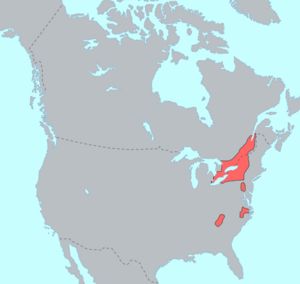Iroquoian languages facts for kids
Quick facts for kids Iroquoian |
|
|---|---|
| Geographic distribution: |
eastern North America |
| Linguistic classification: | One of the world's primary language families |
| Proto-language: | Proto-Iroquoian |
| Subdivisions: |
Northern Iroquoian
|
| ISO 639-2 and 639-5: | iro |
 Pre-European contact distribution of the Iroquoian languages.
|
|
The Iroquoian languages are a group of languages spoken by Native American (or indigenous) peoples in eastern North America. These languages are special because they usually don't use sounds made with both lips, like 'p' or 'm'. They are also known as polysynthetic languages. This means they can pack a lot of meaning into one long word, almost like a whole sentence! They are also head-marking, which means important grammar information is often found at the beginning of words.
Sadly, as of 2020, most Iroquoian languages are in danger of disappearing. Only a few older people still speak them. For example, Mohawk in New York and Cherokee have the most speakers. However, less than 10% of their tribal members speak these languages fluently.
Contents
Iroquoian Language Families
The Iroquoian languages are divided into two main groups: Northern Iroquoian and Southern Iroquoian. Many languages in these groups are now extinct or dormant. This means they are no longer spoken every day.
Northern Iroquoian Languages
The Northern Iroquoian group includes several smaller families:
- Lake Iroquoian
- Huronian (extinct)
- Huron-Wyandot (extinct)
- Petun (Tobacco) (extinct)
- Tuscarora–Nottoway (extinct)
- Unclear (languages with less information)
- Wenrohronon/Wenro (extinct)
- Neutral (extinct)
- Erie (extinct)
- Laurentian (extinct)
Southern Iroquoian Languages
The Southern Iroquoian group mainly includes dialects of Cherokee:
- Cherokee language
- Cherokee (South Carolina-Georgia Dialect) (extinct)
- Cherokee (North Carolina Dialect) (very endangered)
- Cherokee (Oklahoma Dialect) (endangered)
Understanding Extinct Languages
Some languages, like Laurentian, might have been more than one dialect. Experts are still studying this. We know more about Huron and Petun languages thanks to old records. These records came from working with Wyandot elders.
However, languages of tribes like the Wenrohronon, Conestoga, Neutral Nation, and Erie Nation are not well-documented. The Neutral people were called Atiwandaronk by the Huron. This means 'they who understand the language.' Many of these tribes were defeated by 1660. Their people either formed new tribes or joined others. Adopting brave enemies into the tribe was a common tradition among Iroquoian peoples.
The Meherrin people lived near the Tuscarora and Nottoway tribes. They might have spoken an Iroquoian language too. But there isn't enough information to be sure.
Connecting Language Families
Some researchers have tried to link Iroquoian languages with Siouan and Caddoan languages. They call this a "Macro-Siouan" family. However, this idea has not been fully proven yet.
Learning and Saving Languages
Many people are working hard to save these important languages.
- In 2012, Syracuse University started a program. It helps students and teachers learn Iroquois linguistics. This helps them work on bringing the languages back to life.
- Six Nations Polytechnic in Ohsweken, Ontario offers special courses. You can get a diploma or degree in Mohawk or Cayuga.
- Since 2017, the University of Waterloo in Waterloo, Ontario has offered a Mohawk course. It's taught at Renison University College. This is done with the Waterloo Aboriginal Education Centre.
See also
- Proto-Iroquoian language
 In Spanish: Lenguas iroquesas para niños
In Spanish: Lenguas iroquesas para niños


